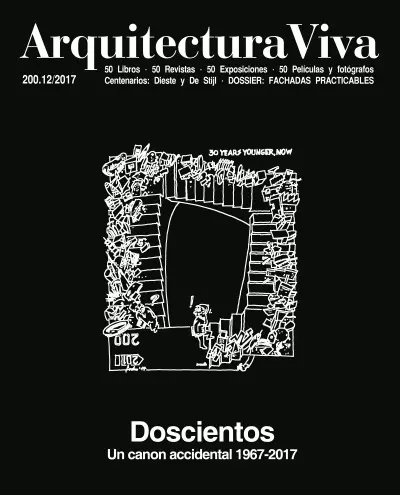

This publication revisits ten years of architectural and urban experimentation in Logroño, whose festival Concéntrico has put La Rioja’s capital on the map of contemporary debate. Instead of just documenting the 150+ projects exhibited, the book is a
Satori has published the result of exhaustive, stimulating research conducted by Japan-based architect Jorge Almazán and Studiolab, his laboratory at Keio University. It combines explanatory texts with abundant original graphics in three main forms:
Houston has 2,800 km² of asphalt, an area larger than metropolitan Madrid. And though a few North American cities try to curb private vehicular traffic and improve public transport, the sprawl keeps growing, not only in the US but the world over, as
The protean personality of Salvador Rueda combines a scholar’s rigor, which impregnates both his theoretical mind and his professional practice, with a communicator’s power. Frequenters of his writings and works enjoy the spin of unexplored perspect
Museums are not dead, they multiply. After their central role in the economic euphoria of the 1990s, the Great Recession of 2008 and the pandemic of 2020, along with different military and environmental crises, should have transformed the cultural an
“We are all pilgrims who seek Italy.” As Goethe’s poem notes, with the popularization of the Grand Tour in the 18th century, il bel paese became the quintessential destination and few could help succumbing to the search for the ideal of beauty in its
Looking arouses curiosity. This goes for a chemist peering through a microscope or an astronomer through a telescope. Also, whether for a photojournalist with the lens or a painter with trained eyes, observation is a constant that underlies all appro
What happens when an architect sets out to design without a preliminary scheme, and speaks with the builder only via WhatsApp? Manuel Ocaña transforms what could have been a minor anecdote – turning a pigsty into a family room – into a deep, non-comp
On the wooded hills of Saint-Cloud, outside Paris, stands a distinctive house. Dominique Boudet, editor-in-chief of Le Moniteur, tasked OMA in 1984 to build a home with conditions stipulated by his wife, Lydie Dall’Ava, who wanted bespoke spaces for
Compiling families of carpentry joints has always been an arduous, practically unmanageable task. In a huge effort, Sascha Bauer and Daniel Pauli have not only collected a myriad, but also built a cross-cultural bridge by investigating their typologi
The production of renewable sources has transformed territories, and now also the buildscapes of cities. Advances in solar capture technologies, their reduced costs, and the inclusion of photovoltaic panels in technical codes have made them prolifera
Here is a compilation of conversations that took place at O Instituto, an independent space in Porto for sharing experiences of colonial processes, founded by Paulo Moreira. At first it looks like an introduction to decolonial theory and practice, pr
Discussions on neoliberalism nowadays pose two problems. The first comes from the vagueness of the term, turned as it is into a non-concept, devoid of content; a mantra which has embodied everything malign about the capitalism. On the other hand, at
The ancient world nurtures us with histories and myths, and two recent books offer this spiritual food in easily digestible bites. David Hernández de la Fuente, professor of Greek philology at Madrid’s Complutense, whose Pequeña historia mítica de Es
A rare bird in the contemporary architectural scene is OFFICE. Few architects have managed to combine practice and theory with acumen, but for Kersten Geers and David Van Severen – as for their admired Rossi and Venturi – they are inseparable, and th
Many good stories are the product of chance. As in a Borges tale, in the spring of 2014 Léa Namer stumbled upon the Sexto Panteón of the Chacarita Cemetery in Buenos Aires: a maze of niches, stairs, and light wells under a meadow. After the katabasis
Women Architects at Work, de Mary Anne Hunting y Kevin D. Murphy, relata en una cuidada edición cómo en la Escuela de Arquitectura y Paisajismo de Cambridge en Massachusetts, entre los años 1916 y 1942, un considerable número de mujeres estudió Arqui
Three Spanish academics defend reason, freedom, and science with ambitious works in several volumes, and a German philosopher culminates a trilogy on 20th-century thought glimpsing the dawn of a new Enlightenment. The philologist Darío Villanueva has
It has taken barely forty-five years for there to be a Spanish edition of Genius loci. Paesaggio ambiente architettura, a book by the Norwegian critic and historian Christian Norberg-Schulz which first came in Italian in 1979. In the interim it has b
In an era of incessant confrontation – when misinformation, conflict and and polarization reign – public opinion barely even agrees on the challenges to address. But recent times have seen the spread of a certain unanimity on housing. We are stunned
The Barcelona of the past is the one we look to for its exemplary city-making. But, as Oriol Bohigas wrote, the city is not people: the brilliant operations were those focused on public space, on facilities, on infrastructures; meanwhile, Barcelonian
The publisher Arquitectura Viva recently released a volume on Eduardo Souto de Moura, with a preface penned by Luis Fernández-Galiano and an introductory article by Kenneth Frampton. It is an exhaustive revision, counting as many as 340 pages, that g
From Zuazo, Palacios, or Gutiérrez Soto to Higueras, Peña Ganchegui, or Moneo, many of contemporary Spanish architecture’s greatest figures have come from Madrid’s School of Architecture. Much of our urban landscape bears the mark of ETSAM, which has

